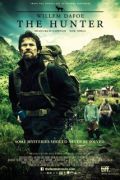
Directed by
Daniel Nettheim
101 minutes
Rated M
Reviewed by
Sharon Hurst


The Hunter
Synopsis: Mysterious European biotech company, Redleaf, sends mercenary hunter Martin (Willem Dafoe) to Tasmania in search of the believed-to-be extinct Tasmanian tiger. Jack Mindy (Sam Neill) helps Martin get lodging with a local family - children Sass (Morgana Davies) and Bike (Finn Woodlock) and their depressed mother, Lucy (Frances O’Connor), whose husband has been missing in the wilderness for many months. Martin’s mission is kept secret from the locals, but he soon gets the sense that he is being watched. As his bond with the host family deepens, and local tensions run high between loggers and greenies, Martin is forced to face some serious issues of conscience.This impressive film is based upon the debut novel by Julia Leigh, who recently directed Sleeping Beauty. Both pieces of work have a detached, almost other-worldly quality, and in The Hunter it is in no small part due to the unsettling way in which the Tasmanian bush is used through much of the film. The entire shoot was in Tasmania, from Mt. Wellington through the rugged plateaux and in small logging towns. The remoteness serves as a backdrop for many of the film’s themes – isolation, loneliness, survival, fear, grief, and a journey of transformation, especially for the central character. The scenes in the wilderness are majestic, eerily beautiful and lovingly filmed.
Dafoe, looking ruggedly handsome with a beard, brings many facets to Martin, all slowly revealed as the plot progresses. When we meet him he is distant, reserved, cloaked in his own thoughts. Arriving at the run-down cottage in which he has been billeted he finds things in disarray – the generator won’t work, the water runs brown, the house is a mess and Lucy is most times sedated and sleeping. And so his first connection is with her curious, high-spirited children who seem grateful for a male figure being around since the disappearance of their father. As Lucy gradually returns to the real world, we get a sense of the possibility of a new start for her and the children,.
The search for the possibly non-extinct tiger, seen in fascinating archival footage on Martin’s lap-top, is the primary thrust of the film’s narrative. So caught up in the search was I that every bushland shot had me scouring the screen for a possible sighting. But it is Martin’s relationship to his quest that is of vital importance. As Martin develops closeness and compassion in his relationships, so he also begins to question what he is doing in terms of Redleaf’s design for the creature, should it be discovered. In this respect the tiger could also be seen as symbolic – its elusiveness mirroring the elusiveness of love and connection in our modern world and its demise reflecting the dire effects of colonisation on native cultures (infamously, the Tasmanian aboriginal was also wiped out by English settlers).
Conservationist themes emerge with tensions between local loggers and the greenies they despise. Scenes in the local pub are tense and authentic, as the local loggers spoil for a fight with Martin, believing him to be a greenie. Jack is caught between both sides, recognising the need to keep the big trees, but also the need for people in the community to have employment.
The film works like a slow burn – nothing happens fast, full respect is paid to nature and the process of the hunt, with characters allowed to develop gradually. I found myself mesmerised by Martin’s meticulous expeditions, by the grandeur of the landscape, and particularly by the performances of the leads, including the children.
Want something different?





